|
Revell's 1/72 scale
Focke-Wulf Fw 200 C-8
by Chris Wauchop
|
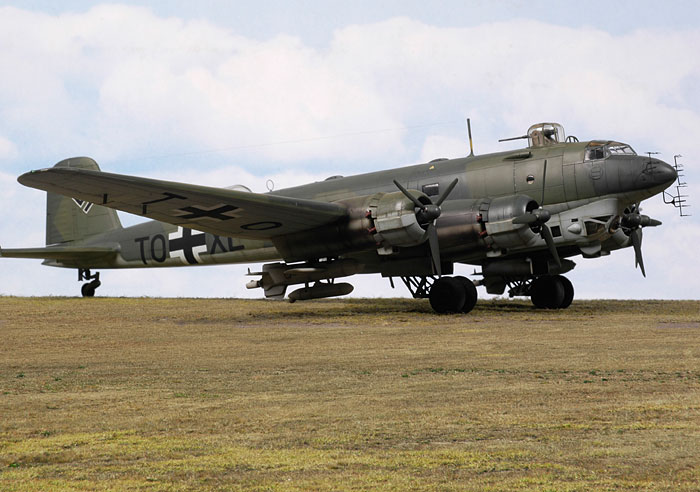
|
|
Focke-Wulf Fw 200 C-8
Condor |
images by Brett Green

Revell's 1/72 scale Fw 200 C-5/C-8 Condor is available online from
Squadron.com for US$18.00!
Revell's 1/72 scale Condor in the box
Revell's 1/72 scale Focke-Wulf Fw 200 C was released in late 2006.
This kit features all new tooling, and is not an adaptation of any
earlier Condor kit.
This new model comprises 214 parts in grey styrene, 26 parts in clear
styrene and markings for four aircraft.
Surface detail is excellent, comprising mainly fine and crisply
engraved panel lines but including selected recessed rivets, subtle
fabric texture and raised features where appropriate.
Detail parts are equally impressive. Without resorting to a very
complicated kit breakdown, Revell has managed to mould a great deal of
detail onto the important internal areas including the engines and the
cockpit. The fine cooling fins on the engines and the quilted seat
cushions are especially nice.
The surface features and detail on Revell's new 1/72 scale Focke-Wulf
Fw 200 C-5/C-8 would not look out of place on a 1/48 scale kit.
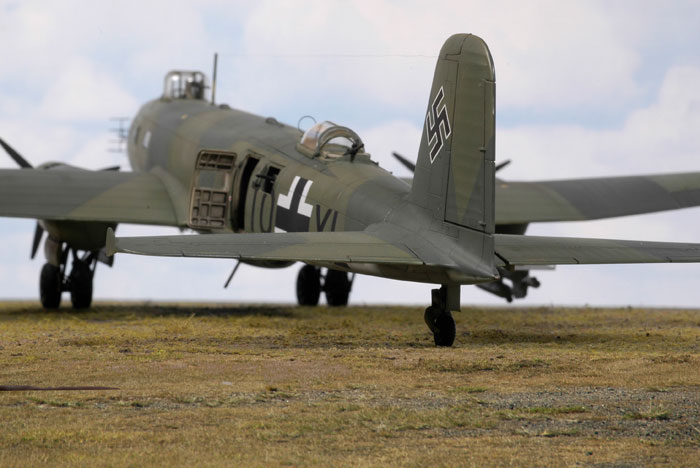
Two Henschel Hs 293 guided bombs are included.
Clear parts are very well done, being thin and free of
distortion.
It is also pleasing to note the total absence of ejector
pin circles or sink marks on any outside surface of any of the parts.
This is a testament to clever planning, and is especially welcome in
this smaller scale where an ejector pin mark in the wrong place can
render a part almost useless.
Markings are supplied for four aircraft. All are
finished in the standard maritime finish of RLM 72 / 73 / 76 (although I
would have suggest 65 as the lower surface colour), with one of the
options including an intricate "wave-mirror" pattern of RLM 76 over the
fuselage sides and engine nacelles. The decals appear to be well printed
and in good register.
The decal sheet includes stencil markings - although no
stencil placement guide is included - plus decal dials as an option for
the instrument panel.
General construction was quite straightforward despite some
misleading instructions. Fit of the model was very good. In fact, the
panels housing the turret and mid-upper machine gun are not glued in
place permitting the parts to be removed, revealing interior detail
beneath.
The Eduard exterior detail photo-etched set (item number 72 463) was
used on the model. This was very nice indeed.
Some of these photo-etched details were very fine, including the
radar arrays on the nose of the model.
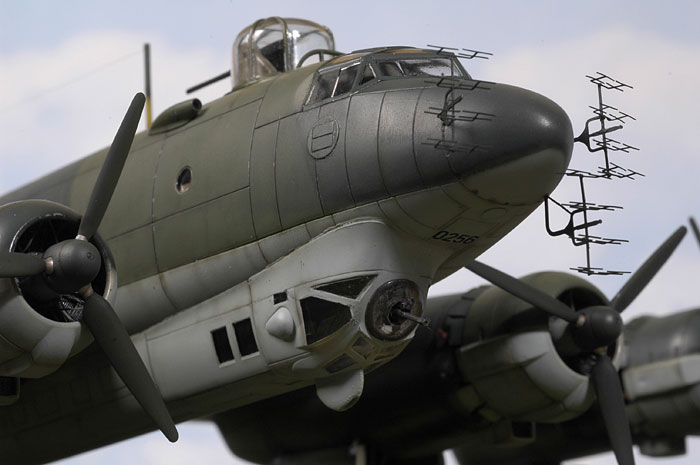
Eduard also included photo-etched parts for the DF loop, antennas and
the Hs 293 glide bombs. Internal cowling braces and ignition harnesses
also add a new dimension of detail to this already very good kit.
The front turret seemed to sit a little too tall, so the base of the
clear part was trimmed and sanded to a more appropriate height.
Metal crosshair wire was used for the main antenna wire. The real
wire had two lead-ins between the main cable and the fuselage, but the
wire is so fine that this would have been almost impossible to achieve.
Even in this scale, when finished the Condor is a big, impressive
model.
 The
model was painted using the metal bodied Testor Aztek airbrush fitted
with the fine tan-coloured tip. The
model was painted using the metal bodied Testor Aztek airbrush fitted
with the fine tan-coloured tip.
The lower surfaces were painted using Gunze Sangyo H67 RLM 65 Light
Blue, lightened slightly for scale effect with Flat White.
The RLM 73 on the upper surface is a mix of 50% Gunze Sangyo H64 RLM
71 with 30% Tamiya XF-18 Medium Blue and 20% Gunze H422 RLM 82 Light
Green.
RLM 72 was a mix of Tamiya XF-18 Medium Blue and Gunze H422 RLM 82
Light Green.
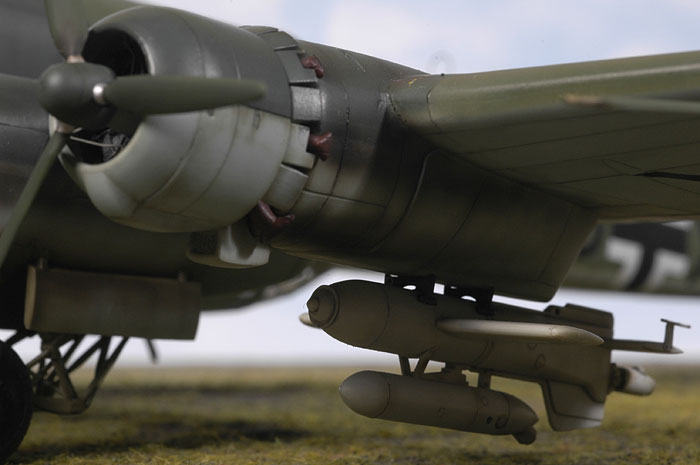
The Henschel Hs 293 glide bombs were finished using Gunze H334 Barley
Grey.
Canopy frames were outlined in a thin mix of Tamiya X-18 Semi Gloss
Black.
The final finish was a coat of Polly Scale Acrylic Flat.
The model was photographed in HyperScale's studio using a Nikon D70
digital SLR. Illumination was via two studi flash units - one Bowens 250
and a generic 100 flash - on stands and illuminating from a high 45º
angle from each side of the front of the photography table.
The camera was fitted with a Micro
Nikkor 60mm lens.
ISO was set to 250, and the manual
shooting settings were 1/100 of a second at f.29. The high aperture
ensures good depth of field.
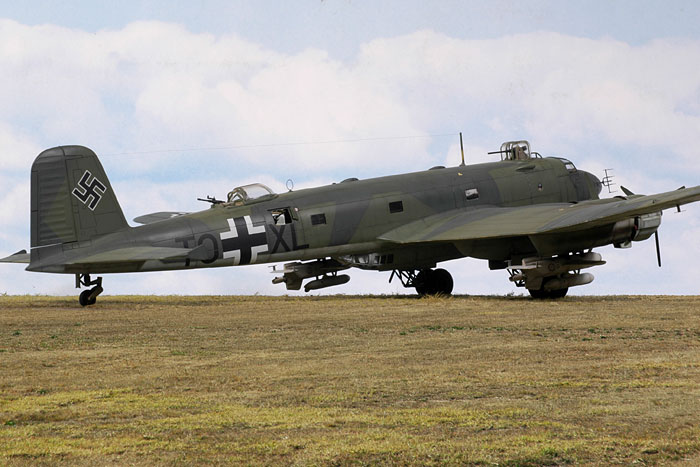
The model was placed on a base of static
grass in front of an enlarged photograph of sky. The images were
optimized (brightness and contrast) in Photoshop CS, resized to 700
pixels in width and saved as 75 dpi .jpg files using Photoshop's "Save
for the Web" option.
For the photos with the extended grass
foreground, the model photo was merged with a photograph of grass taken
at Bankstown Airport in Sydney's south-western suburbs. By sheer dumb
luck, the colour and tone of the grass in the airport photo and the
model photo matched without further manipulation. The demarcation
between the model static grass and the real grass in the foreground was
merged using Photoshop's Clone Stamp tool.
The title image was posed to recreate a
photo on page 179 of "War Eagles in Original Color" by Ethell and Bodie
(Widewing Publications)
Click on the thumbnails
below to view larger images:
[../../photogallery/photo00005981/real.htm]
Model by Chris Wauchop
Text Copyright © 2007 by Chris Wauchop and
Brett Green
Images Copyright © 2007 by
Brett Green
Page Created 01 June, 2007
Last Updated 24 December, 2007
Back to HyperScale
Main Page
|
Home
| What's New |
Features |
Gallery |
Reviews |
Reference |
Forum |